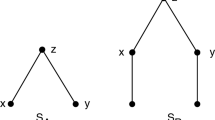Abstract
The conventional approach to causality is based on partial orders. Without additional structure, partial orders are only capable of expressing AND causality. In this paper we investigate a syntactic, or logical, approach to causality which allows other causal relationships, such as OR causality, to be expressed with equal facility. In earlier work, [3], we showed the benefits of this approach by giving a causal characterisation, in the finite case, of Milner's notion of confluence in CCS. This provides the justification for the more systematic study of causality, without finiteness restrictions, which appears here. We identify three general principles which a logic of causality should satisfy. These principles summarise some basic intuitions about events and causality. They lead us to geometric logic — the “logic of finite observations” — as a candidate for a logic of causality. We introduce the formalism of geometric automata based on this choice; a geometric automation is a set E together with a pair of endomorphisms of the free frame (locale) generated by E. Our main result is to show that Winskel's general event structures are a special case of geometric automata. This is analogous to the transition from topological data (sets of points) to algebraic structures (lattices of open subsets) in “pointless topology”, [6]. This result links our ideas on causality with Winskel's theory of events in computation; it provides a syntax for describing event structures and it opens the way to giving a causal interpretation of event structure phenomena. We show further that geometric automata give rise to domains of configurations which generalise the event domains of Winskel and Droste.
Preview
Unable to display preview. Download preview PDF.
Similar content being viewed by others
References
S. Abramsky. Domain theory in logical form. Annals of Pure and Applied Logic, 1989.
M. Droste. Event structures and domains. Theoretical Computer Science, 68:37–47, 1989.
J. Gunawardena. Causal Automata I: Confluence ≡ {AN D, OR}-Causality. In M. Z. Kwiatkowska, M. W. Shields, and R. M. Thomas, editors, Semantics for Concurrency, pages 137–156. Springer Workshops in Computing, 1990. To appear in TCS.
J. Gunawardena. Eventless structures? (extended abstract). In Third Workshop on Concurrency and Compositionality, Goslar, March 1991.
P. T. Johnstone. Stone Spaces, volume 3 of Studies in Advanced Mathematics. Cambridge University Press, 1982.
P. T. Johnstone. The point of pointless topology”. Bulletin American Mathematical Society, 8(1):41–53, 1983.
R. Milner. Communication and Concurrency. International Series in Computer Science. Prentice-Hall, 1989.
M. Nielsen, G. Plotkin, and G. Winskel. Petri nets, event structures and domains. Theoretical Computer Science, 13:85–108, 1981.
M. Smyth. Powerdomains and predicate transformers: a topological view. In J. Diaz, editor, Automata, Languages and Programming. Springer LNCS 154, 1983.
P. S. Thiagarajan. Some behavioural aspects of net theory. In T. Lepistö and A. Salomaa, editors, Automata, Languages and Programming. Springer LNCS 317, 1988.
R. van Glabbeek and U. Goltz. Equivalence notions for concurrent systems and refinement of actions. Arbeitspapiere 366, GMD, February 1989.
S. Vickers. Topology via Logic, volume 5 of Cambridge Tracts in Theoretical Computer Science. Cambridge University Press, 1989.
G. Winskel. Events in Computation. PhD thesis, University of Edinburgh, 1980.
G. Winskel. Event structures. In W. Brauer, W. Reisig, and G. Rozenberg, editors, Advances in Petri Nets. Springer LNCS 255, 1987.
Author information
Authors and Affiliations
Editor information
Rights and permissions
Copyright information
© 1991 Springer-Verlag Berlin Heidelberg
About this paper
Cite this paper
Gunawardena, J. (1991). Geometric logic, causality and event structures. In: Baeten, J.C.M., Groote, J.F. (eds) CONCUR '91. CONCUR 1991. Lecture Notes in Computer Science, vol 527. Springer, Berlin, Heidelberg. https://doi.org/10.1007/3-540-54430-5_94
Download citation
DOI: https://doi.org/10.1007/3-540-54430-5_94
Published:
Publisher Name: Springer, Berlin, Heidelberg
Print ISBN: 978-3-540-54430-2
Online ISBN: 978-3-540-38357-4
eBook Packages: Springer Book Archive




